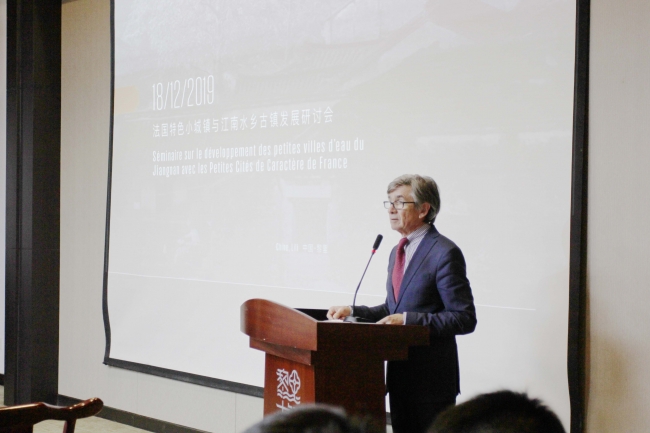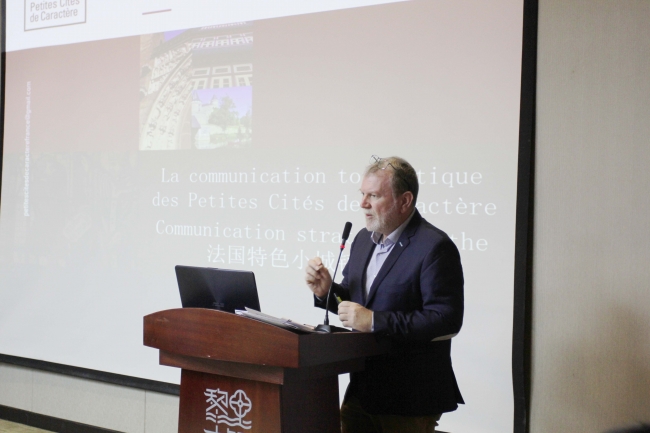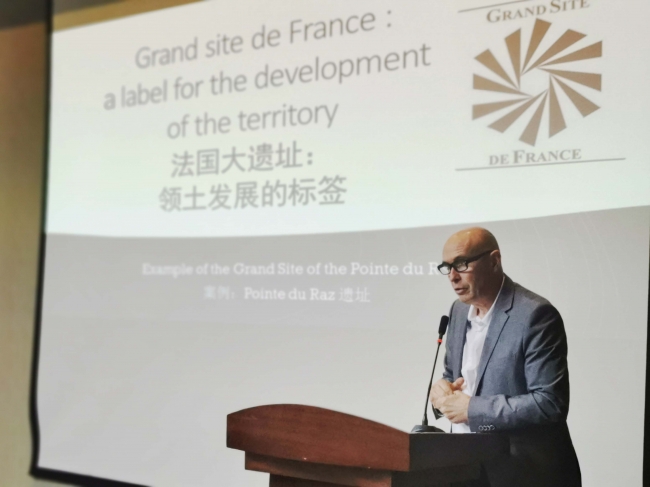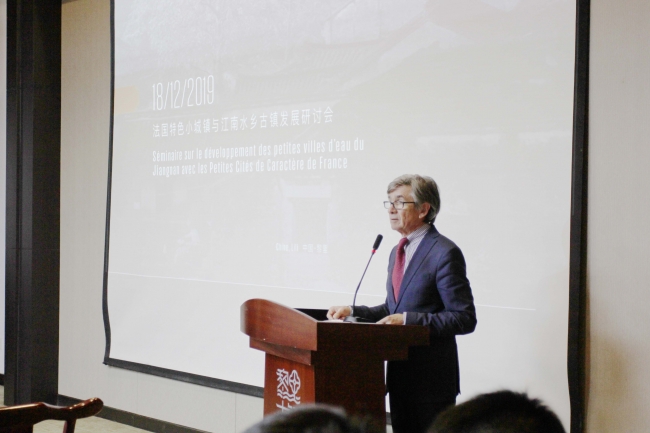| Franco Chinese Seminar on the development of ancient towns |
| Author:Zhang Zhuo、Dong Anqi、Marie-Noe PublishDate:2019-12-26 Hits:3032 |
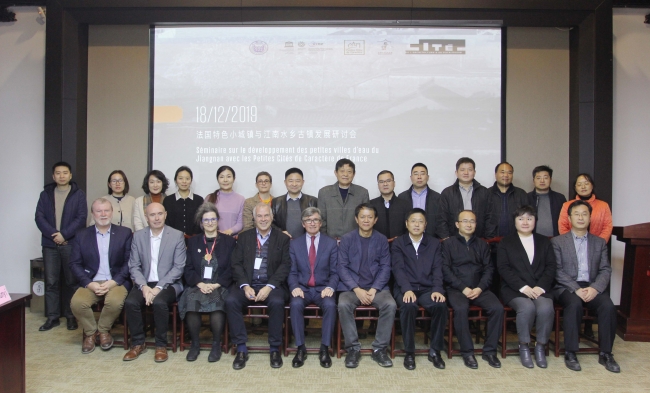 Group photo
December 18, 2019, the seminar on the development of the Jiangnan ancient water towns with the French small towns of character association (Association des Petites Cités de Caractère -- PCC) was held by WHITRAP Shanghai in Lili town, Wujiang district, Suzhou City, Jiangsu Province. Representatives from the smallwater towns of Lili, Jinxi, Zhouzhuang, Xitang, Tongli, Zhenze, Zhujiajiao,Jinze, Luxu, Nanxun and Qiandeng, representatives of the Executive Committee of Yangtze River Delta ecological green integrated development demonstration zone,and the representatives of China Academy of Urban Planning and Design (Shanghai) – more than 60 participants all -- attended the seminar.
The objective of the seminar was to create a dialogue between French mayors and Chinese leaders and different stakeholders on urban conservation and small town development by sharing experiences, discussing practical solutions to key problems. The aim was to discuss the role and function of heritage today in relation to an integrated, ecological sustainable development strategy. It explored how small historic towns can promote their heritage and revitalize their urban functions attract new residents and focus on their well-beings.
Several topics were addressed such as giving new functions to historic buildings, imagining new activities in and outside historic towns, inventing new economic models and developing economic diversity. The cross-cutting theme was exploring how heritage can be a driver for the development of small towns and their surrounding territories. PCC highlighted how the networkof small towns allowed them to strengthen their capacities and benefit from each other so “1+1 greater than 2”.
Presentations of PCC
Roger Bataille Topic:Making historic cities more attractive: why, for whom, how and with what benefits
Laurent Mazurier Topic: Introduction for the branding, communication and promotion tools of PCC
Presentations
Benoit Lauriou
Case study: New medical centre created in a historic building in Pont-Croix. Benoit Lauriou shared the experience of developing a new medical center in a disused historic building in Pont-Croix and showcased the multiple benefits and outcomes of such an initiative. He explained how this project not only provided the local residents with the medical service they needed but also allowed to save a major historic building by giving it a new function. It ensured the necessary funding for a high-quality restoration respectful of the building, integrity and authenticity. Such an initiative had a multiplier effect as the new medical centre not only addressed the needs of the inhabitants of Pont-Croix but attracted new residents to the town interested in on site amenities or short-term visitors from neighboring towns which did not have access to such services locally. The implementation of this project was only possible because different stakeholders cooperated together. Benoit Lauriou also referred to another example following the same rational, the development of social housing in another disused historic building. Both cases show how reusing heritage can ensure historic towns are living and dynamic settlements adapted to contemporary needs and how reusing historic buildings and historic areas can also curb urban sprawl and thus contribute to a more sustainable urban development.
Roger Bataille
Case study:Creation of a stain glass art centre in Ervy-le-Chatel
Roger Bataille presented the creation of a stain glass arts center in Ervy-le-Chatel in a former disused prison. He explained why this small town had very important Renaissance period stained glass windows, developed by Italian artists attracted by wealthy merchants when Ervy-le-Chatel was a then thriving commercial hub on the Champagne Fair route. The new Center interacts with the local community, local residents participate, events, visiting tours, workshop and art competitions.
The Center is also a tool to promote and revitalize stained glass craftsmanship by supporting artists and craftsmen and promoting modern design. This project benefited the town by strengthening the local cultural identity influencing crafts and ensuring the promotion of the town and its project through the use of social media. He also emphasized that enhancing heritage gives the opportunity to the towns to improve.
Case study:Development of slow tourism and outdoors activities in natural and rural environments. Example: Pointe du Raz Great Site of France area. Benoit Lauriou presented the primary purpose of the “Grand site de France” and its rational to protect biodiversity and cultural and natural heritage, as well as the landscape to create a pleasant environment for local residents and tourists. Considering the problem of excessive tourism, he explained the large scale heritage enhancement project he was involved in as his town Pont-Croix is an entry point to the Site and as he is a member of the management board of the Site. The management project integrated the requirements of heritage protection and economic development, through the promotion for example of outdoor activities, and by installing corresponding services and facilities. Supporting the development of a variety of new activities is a way to spread out tourists flows and visitors as well as developing a new relationship to the natural environment. When people engage with their environment they become caretakers of a site rather than consumers. Furthermore, these new outdoor activities allowed the development of a series of new locally based businesses.
Case study:New ways of discovering historic towns and their environment: trails and thematic routes Laurent Mazurier gave an overview of the development of thematic and cultural routes and the shift from car focused routes to the development of hiking trails and bicycle routes. He explained how the changes in tourism trends had a great impact on urban management and the wider setting of ancient towns. Today number of tourists favor slow tourism. With the continuous growth of the tourism market, Laurent Mazurier indicated that the small towns could promote their character and uniqueness to address the desire of tourists for something different. Small towns should become alternative destinations and become a destination and stopover of cultural routes by designing new itineraries, developing trails and thematic routes as well as favoring alternative transport modes. In this way, we could integrate new services, develop new forms of travel, alternative transport modes and promote new ways for tourists to explore the specific culture of towns and cities.
Case study:Maintaining black bee pollination methods and black wheat production
|
- News | WHITRAP Shanghai and CNR-ISPC bilateral meeting
- News | WHITRAP meets Cité de l’Architecture et du Patrimoine
- WHITRAP Hosting "Workshop on Preliminary Assessment for National Focal Points of the Asia Region" in Chengdu
- WHITRAP Shanghai meets UNESCO
- INTERNATIONAL CONFERENCE PRELIMINARY ANNOUNCEMENT & CALL FOR PAPERS
- Observation of the 46th Session of the World Heritage Committee
Copyright © 2009-2012 World Heritage Institute of Training and Research-Asia and Pacific (shanghai)


